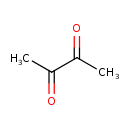|
Record Information |
|---|
| Version |
1.0 |
|---|
| Update Date |
1/22/2018 11:54:54 AM |
|---|
|
Metabolite ID | PAMDB120562 |
|---|
|
Identification |
|---|
| Name: |
diacetyl |
|---|
| Description: | An α-diketone that is butane substituted by oxo groups at positions 2 and 3. It is a metabolite produced during the malolactic fermentation. |
|---|
|
Structure |
|
|---|
| Synonyms: | - 2,3-Butadione
- 2,3-butandione
- 2,3-Butanedione
- 2,3-Diketobutane
- 2,3-Dioxobutane
- Biacetyl
- Diacetyl
- diacetyl
- Dimethyl glyoxal
- Dimethylglyoxal
|
|---|
|
Chemical Formula: |
C4H6O2 |
|---|
| Average Molecular Weight: |
86.09 |
|---|
| Monoisotopic Molecular
Weight: |
86.03678 |
|---|
| InChI Key: |
QSJXEFYPDANLFS-UHFFFAOYSA-N |
|---|
| InChI: | InChI=1S/C4H6O2/c1-3(5)4(2)6/h1-2H3 |
|---|
| CAS
number: |
431-03-8 |
|---|
| IUPAC Name: | butane-2,3-dione |
|---|
|
Traditional IUPAC Name: |
diacetyl |
|---|
| SMILES: | CC(C(C)=O)=O |
|---|
|
Chemical Taxonomy |
|---|
|
Taxonomy Description | This compound belongs to the class of organic compounds known as alpha-diketones. These are organic compounds containing two ketone groups on two adjacent carbon atoms. |
|---|
|
Kingdom |
Organic compounds |
|---|
| Super Class | Organic oxygen compounds |
|---|
|
Class |
Organooxygen compounds |
|---|
| Sub Class | Carbonyl compounds |
|---|
|
Direct Parent |
Alpha-diketones |
|---|
| Alternative Parents |
|
|---|
| Substituents |
- Alpha-diketone
- Organic oxide
- Hydrocarbon derivative
- Aliphatic acyclic compound
|
|---|
| Molecular Framework |
Aliphatic acyclic compounds |
|---|
| External Descriptors |
- alpha-diketone (CHEBI:16583)
- Oxygenated hydrocarbons (LMFA12000012)
- a small molecule (DIACETYL)
|
|---|
|
Physical Properties |
|---|
| State: |
Liquid |
|---|
| Charge: | 0 |
|---|
|
Melting point: |
-2.4 °C |
|---|
| Experimental Properties: |
| Property | Value | Reference |
|---|
| Melting Point | -2.4 °C | Not Available | | Boiling Point | Not Available | Not Available | | Water Solubility | 200 mg/mL at 15 °C | Not Available | | LogP | -1.34 | HANSCH,C ET AL. (1995) |
|
|---|
| Predicted Properties |
|
|---|
|
Biological Properties |
|---|
| Cellular Locations: |
Not Available |
|---|
| Reactions: | |
|---|
|
Pathways: |
Not Available |
|---|
|
Spectra |
|---|
| Spectra: |
| Spectrum Type | Description | Splash Key | |
|---|
| Predicted GC-MS | Predicted GC-MS Spectrum - GC-MS | Not Available |
|---|
| LC-MS/MS | LC-MS/MS Spectrum - Quattro_QQQ 10V, Positive (Annotated) | splash10-000i-9000000000-4e7132ef8eb6971544b1 | View in MoNA |
|---|
| LC-MS/MS | LC-MS/MS Spectrum - Quattro_QQQ 25V, Positive (Annotated) | splash10-00r5-9000000000-0cc5c90a4394d550268f | View in MoNA |
|---|
| LC-MS/MS | LC-MS/MS Spectrum - Quattro_QQQ 40V, Positive (Annotated) | splash10-06dj-9000000000-a74bfecfcdb93a5c3e07 | View in MoNA |
|---|
| LC-MS/MS | LC-MS/MS Spectrum - EI-B (HITACHI M-80B) , Positive | splash10-0006-9000000000-eeaaf8aa838a1d6a7dde | View in MoNA |
|---|
| LC-MS/MS | LC-MS/MS Spectrum - EI-B (HITACHI RMU-7M) , Positive | splash10-0006-9000000000-171c3774c90fd50b6d6b | View in MoNA |
|---|
| Predicted LC-MS/MS | Predicted LC-MS/MS Spectrum - 10V, Positive | splash10-000i-9000000000-e8c63126caa0f371f336 | View in MoNA |
|---|
| Predicted LC-MS/MS | Predicted LC-MS/MS Spectrum - 20V, Positive | splash10-00kr-9000000000-82affa84acc0579c193b | View in MoNA |
|---|
| Predicted LC-MS/MS | Predicted LC-MS/MS Spectrum - 40V, Positive | splash10-0udi-9000000000-f63598734c0af05eb392 | View in MoNA |
|---|
| Predicted LC-MS/MS | Predicted LC-MS/MS Spectrum - 10V, Positive | splash10-000i-9000000000-e8c63126caa0f371f336 | View in MoNA |
|---|
| Predicted LC-MS/MS | Predicted LC-MS/MS Spectrum - 20V, Positive | splash10-00kr-9000000000-82affa84acc0579c193b | View in MoNA |
|---|
| Predicted LC-MS/MS | Predicted LC-MS/MS Spectrum - 40V, Positive | splash10-0udi-9000000000-f63598734c0af05eb392 | View in MoNA |
|---|
| Predicted LC-MS/MS | Predicted LC-MS/MS Spectrum - 10V, Negative | splash10-000i-9000000000-2599bbcd002f75cefa1d | View in MoNA |
|---|
| Predicted LC-MS/MS | Predicted LC-MS/MS Spectrum - 20V, Negative | splash10-000i-9000000000-1171c0cf98959e7315c6 | View in MoNA |
|---|
| Predicted LC-MS/MS | Predicted LC-MS/MS Spectrum - 40V, Negative | splash10-014i-9000000000-7dcc0fc66bb1e551b332 | View in MoNA |
|---|
| Predicted LC-MS/MS | Predicted LC-MS/MS Spectrum - 10V, Negative | splash10-000i-9000000000-2599bbcd002f75cefa1d | View in MoNA |
|---|
| Predicted LC-MS/MS | Predicted LC-MS/MS Spectrum - 20V, Negative | splash10-000i-9000000000-1171c0cf98959e7315c6 | View in MoNA |
|---|
| Predicted LC-MS/MS | Predicted LC-MS/MS Spectrum - 40V, Negative | splash10-014i-9000000000-7dcc0fc66bb1e551b332 | View in MoNA |
|---|
| MS | Mass Spectrum (Electron Ionization) | splash10-0006-9000000000-8d1a3988261033033e03 | View in MoNA |
|---|
| 1D NMR | 1H NMR Spectrum | Not Available |
|---|
| 1D NMR | 13C NMR Spectrum | Not Available |
|---|
|
|---|
|
References |
|---|
| References: |
- Kovacic P, Cooksy AL (2005)Role of diacetyl metabolite in alcohol toxicity and addiction via electron transfer and oxidative stress. Archives of toxicology 79, Pubmed: 15654607
- Gao X, Xu N, Li S, Liu L (2014)Metabolic engineering of Candida glabrata for diacetyl production. PloS one 9, Pubmed: 24614328
|
|---|
| Synthesis Reference: |
Xu, Ping; Chen, Hong; Du, Yi; Chen, Wanqiu; Xiao, Zijun. Method of preparation diacetyl by oxidization. Faming Zhuanli Shenqing Gongkai Shuomingshu (2005), 6 pp. |
|---|
| Material Safety Data Sheet (MSDS) |
Download (PDF) |
|---|
|
Links |
|---|
| External Links: |
|
|---|


